8.2 /10 1 Votes
8.7/10 TV | 7.8/10 IMDb | |||||||||||||||||||||||||||||||||
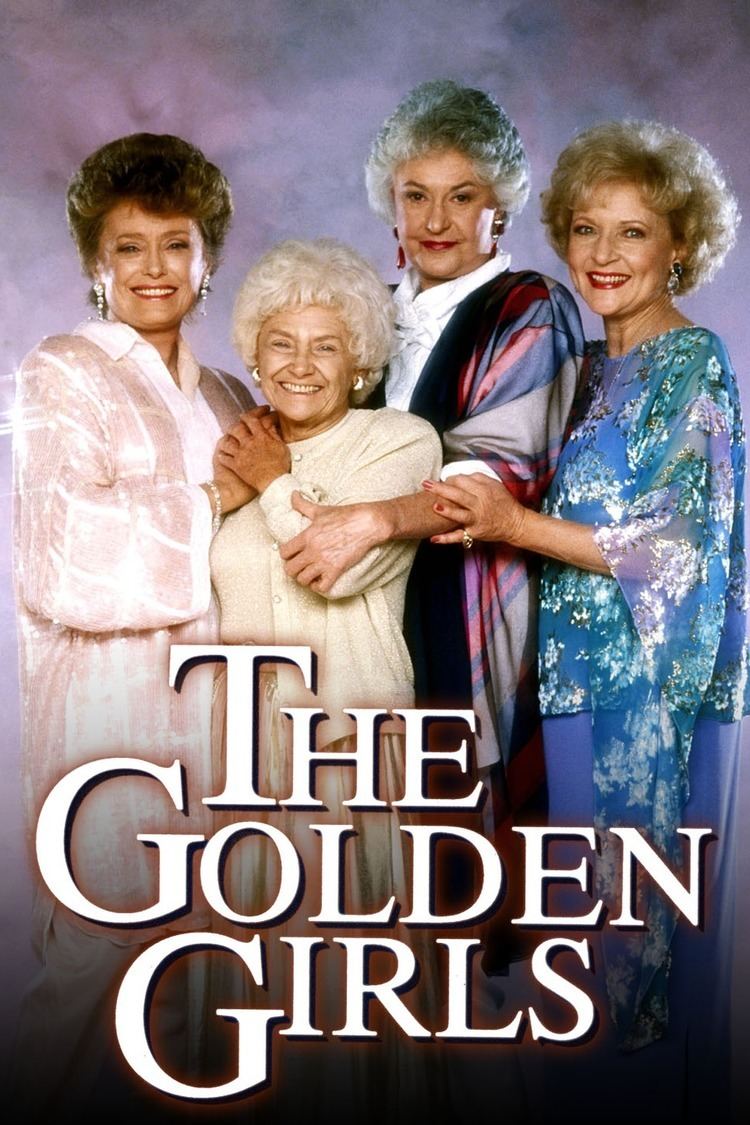 | ||||||||||||||||||||||||||||||||||
Starring Bea ArthurBetty WhiteRue McClanahanEstelle Getty Theme song Thank You for Being a Friend Cast | ||||||||||||||||||||||||||||||||||
The Golden Girls is an American sitcom created by Susan Harris that originally aired on NBC from September 14, 1985, to May 9, 1992, with a total of 180 half-hour episodes spanning over seven seasons. The show stars Beatrice Arthur, Betty White, Rue McClanahan, and Estelle Getty, as four older women who share a home in Miami, Florida. It was produced by Witt/Thomas/Harris Productions, in association with Touchstone Television, and Paul Junger Witt, Tony Thomas, and Harris served as the original executive producers.
Contents
- Premise
- Pilot
- Finale
- Main
- Recurring
- Creation
- Casting
- Writing and taping
- Exterior and interior sets
- Format
- Critical reception
- Awards and nominations
- Syndication
- Home media release
- Spin offs
- The Golden Palace
- Empty Nest
- Nurses
- Stage
- Foreign versions
- Restaurant
- References
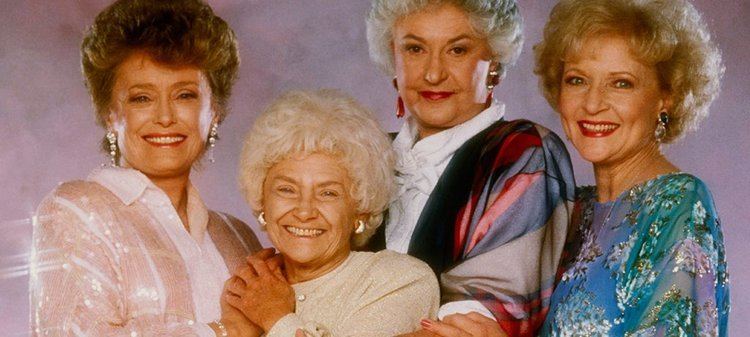
The Golden Girls received critical acclaim throughout most of its run and won several awards, including the Primetime Emmy Award for Outstanding Comedy Series twice. It also won three Golden Globe Awards for Best Television Series – Musical or Comedy. Each of the four stars received an Emmy Award (from multiple nominations during the series' run), making it one of only three sitcoms in the award's history to achieve this. The series also ranked among the top-10 highest-rated programs for six of its seven seasons. In 2013, TV Guide ranked The Golden Girls number 54 on its list of the 60 Best Series of All Time. In 2014, the Writers Guild of America placed the sitcom at number 69 in their list of the "101 Best Written TV Series of All Time".
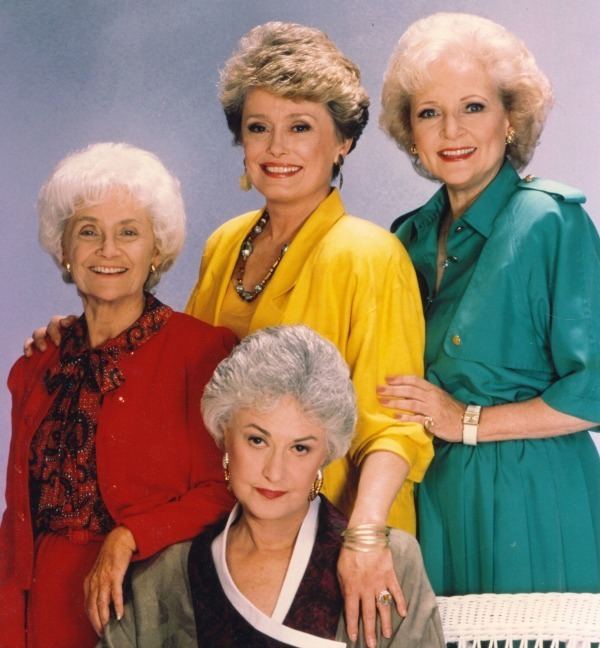
Premise
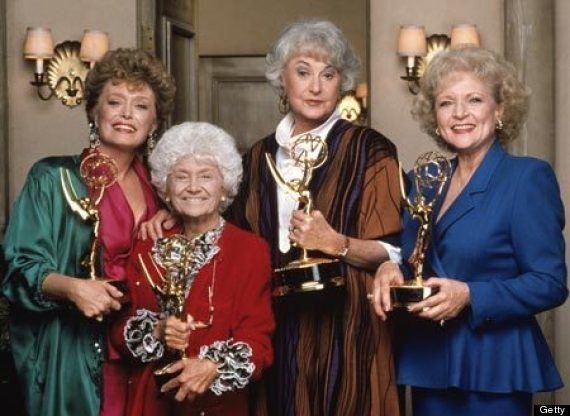
The series revolves around four older, single women (three widows and one divorcée) sharing a house in Miami, Florida. The owner of the house is a widow named Blanche Devereaux (McClanahan), who was joined by fellow widow Rose Nylund (White) and divorcée Dorothy Zbornak (Arthur) after they both responded to a room-for-rent ad on the bulletin board of a local grocery store a year prior to the start of the series. In the pilot episode, the three were joined by Dorothy's 80-year-old mother, Sophia Petrillo (Getty), after the retirement home where she lived burned down.
Pilot

The pilot episode featured a gay character named Coco (played by Charles Levin), who worked as a cook for the women, but the role was eliminated from the series before they began filming the first season. The writers observed that in many of the proposed scripts, the main interaction between the women occurred in the kitchen while preparing and eating food, and decided that a separate cook would distract from that friendship. In addition, the character of Sophia had originally been planned as an occasional guest star, but Estelle Getty had tested so strongly with preview audiences that the producers decided to make Sophia a regular character, which made Coco obsolete.
Finale

After six consecutive seasons in the top 10, and the seventh season at number 30, The Golden Girls came to an end when Bea Arthur chose to leave the series. In the hour-long series finale, which aired in May 1992, Dorothy meets and marries Blanche's Uncle Lucas (Leslie Nielsen), and moves to Hollingsworth Manor in Atlanta, Georgia. Sophia was to join her, but in the end, Sophia stays behind with the other women in Miami, leading into the spin-off series, The Golden Palace. The series finale was watched by 27.2 million viewers. As of 2016, it was the 17th-most watched television finale.
Main
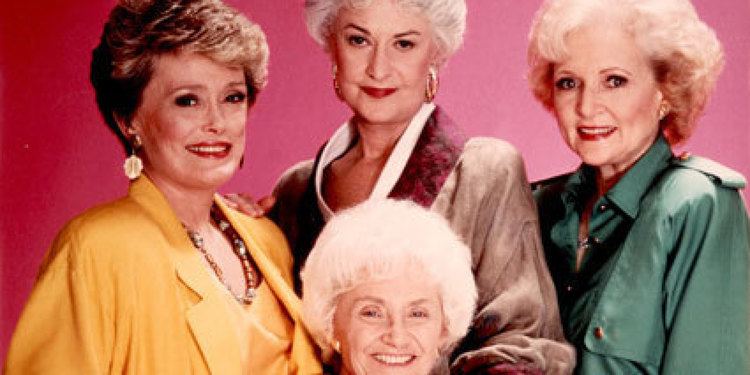
Recurring
Creation
Ideas for a comedy series about older women emerged during the filming of a television special at NBC's Warner Bros. Studios in Burbank, California, in August 1984. Produced to introduce the network's 1984–85 season schedule, two actresses appearing on NBC shows, Selma Diamond of Night Court and Doris Roberts of Remington Steele, appeared in a skit promoting the upcoming show Miami Vice as Miami Nice, a parody about old people living in Miami. NBC senior vice president Warren Littlefield was among the executive producers in the audience who were amused by their performance, and he envisioned a series based on the geriatric humor the two were portraying.
Shortly afterward, he met with producers Paul Junger Witt and Tony Thomas, who were pitching a show about a female lawyer. Though Littlefield nixed their idea, he asked if they would be interested in delivering a pilot script for Miami Nice instead. Their regular writer declined, so Witt asked his wife, Susan Harris, who had been planning to retire after the conclusion of their ABC series Soap. Fortunately, she found the concept interesting, as "it was a demographic that had never been addressed," and she soon began work on it. Though her vision of a sitcom about women in their 60s differed from NBC's request for a comedy about women around 40 years old, Littlefield was impressed when he received her pilot script and subsequently approved production of it. The Cosby Show director Jay Sandrich, who had previously worked with Harris, Witt, and Thomas on Soap, agreed to direct.
The pilot included a gay houseboy, Coco (Charles Levin), who lived with the girls. Levin had been suggested by then-NBC president Brandon Tartikoff based on Levin's groundbreaking portrayal of a recurring gay character, Eddie Gregg, on NBC's Emmy-winning drama Hill Street Blues. After the pilot, the character of Coco was eliminated from the series.
Casting
Hired to film the pilot, director Sandrich also became instrumental in the casting process for the series. Both Rue McClanahan and Betty White came into consideration as the series Mama's Family, in which the two co-starred, had been canceled by NBC. Originally, producers wanted to cast McClanahan as Rose and White as Blanche. The thinking for this was based on roles they previously played; White portrayed man-hungry Sue Ann Nivens on The Mary Tyler Moore Show, while McClanahan co-starred as sweet but scatter-brained Vivian Harmon in Maude. Eager not to be typecast, they took the suggestion of Sandrich and switched roles last-minute.
Though Harris had created the character of Dorothy with a "Bea Arthur type" in mind, Littlefield and the producers initially envisioned actress Elaine Stritch for the part. Stritch's audition flopped, however, and under the impression that Arthur did not want to participate, Harris asked McClanahan if she could persuade Arthur, with whom she worked previously on the CBS sitcom Maude, to take the role. Arthur flipped upon reading the script, but felt hesitant about McClanahan's approach, as she did not "want to play (their Maude characters) Maude and Vivian meet Sue Ann Nivens." She reconsidered, however, after hearing that McClanahan and White had switched roles.
Estelle Getty, who was younger than both Bea Arthur and Betty White, was the last to be cast as the elderly mother of Arthur's character. Tony Thomas spotted her playing the mother role on Broadway in Torch Song Trilogy, and asked her to audition. Getty, who went through a three-hour transformation to become Sophia, wore heavy make-up, thick glasses, and a white wig to look the part. The character of Sophia was thought by the creators to enhance the idea that three retirement-aged women could be young. Disney's Michael Eisner explains, "Estelle Getty made our three women into girls. And that was, to me, what made it seem like it could be a contemporary, young show." As surprising as it may sound, Estelle Getty continuously battled her stage fright. During an interview in 1988, Getty commented on her phobia and expressed how working with major stars, such as Arthur and White, made her even more nervous. At times, she even froze on camera while filming.
Bea Arthur and Betty White were personally distant when not working. This never came across publicly in press, and both acted as consummate professionals on set, as each knew the importance of the other to the overall success of the show. It also did not dull the experience or the enjoyment of doing the show for either one. Betty White has always expressed nothing but love and admiration for Bea Arthur. Only after Arthur's death in 2009 did she reveal their differences were real and due to a fundamental personality clash, with Arthur becoming easily irritated by White's positive, perky demeanor.
Writing and taping
The show was the second television series to be produced by the Walt Disney Company under the Touchstone Television label, and was subsequently distributed by Buena Vista International, Inc. (which holds as the ownership stake in Disney Channel Asia, now Disney–ABC Television Group).
Creator Susan Harris went on to contribute another four episodes to the first season, but became less involved with the sitcom throughout its run; she continued reading all scripts, though, and remained familiar with most of the storylines. Kathy Speer and Terry Grossman were the first head writers of the series and wrote for the show's first four seasons. As head writers, Speer and Grossman, along with Mort Nathan and Barry Fanaro, who won an Emmy Award for Outstanding Writing the first season, gave general ideas to lower staff writers, and personally wrote a handful of scripts each season.
In 1989, Marc Sotkin, previously a writer on Laverne & Shirley and a producer on fellow Witt/Thomas series It's a Living, assumed head-writing responsibilities, and guided the show (to varying degrees) during what were its final three seasons. Richard Vaczy and Tracy Gamble, previously writers on 227 and My Two Dads, also assumed the roles of producers and head writers. Beginning in 1990, Marc Cherry served as writer and producer, years before going on to create Desperate Housewives, which ran on ABC from 2004 to 2012. Mitchell Hurwitz also served as writer for the show in its last two seasons. Hurwitz later went on to create Arrested Development for Fox and later revived for Netflix.
Exterior and interior sets
The house's address was mentioned as being 6151 Richmond Street, Miami. The outside model used in the shots of the house in the series was part of the backstage studio tour ride at Disney's Hollywood Studios. This façade—along with the Empty Nest house—was among those destroyed in mid-2003, as Disney bulldozed the houses of "Residential Street" to make room for its "Lights, Motors, Action!" attraction. A hurricane that damaged the sets earlier also contributed to this decision. The façade is based on a real house in Brentwood, California, located at 245 N. Saltair Ave. and was used in the exterior shots during the first season of the show. Later, the producers built a new model at Walt Disney World in Florida.
The kitchen set seen on The Golden Girls was originally used on an earlier Witt/Thomas/Harris series, It Takes Two, which aired on ABC from 1982 to 1983. However, the exterior backdrop seen through the kitchen window changed from the view of Chicago high-rises to palm trees and bushes for the Miami setting.
Format
The Golden Girls was shot on videotape in front of a live studio audience. Many episodes of the series followed a similar format or theme. For example, one or more of the women would become involved in some sort of problem, often involving other family members, men, or an ethical dilemma. At some point, they would gather around the kitchen table and discuss the problem, sometimes late at night and often while eating cheesecake or some other dessert. One of the other girls then told a story from her own life, which somehow related to the problem (though Rose occasionally regaled a nonsense story that had nothing to do with the situation, and Sophia told outrageous made-up stories). Some episodes featured flashbacks to previous episodes, flashbacks to events not shown in previous episodes, or to events that occurred before the series began. Though the writing was mostly comical, dramatic moments and sentimental endings were included in several episodes. One of the actresses on the show, Bea Arthur, actually hated cheesecake.
Critical reception
During the NBC upfronts, the preview screening of the show got a standing ovation. The show "immediately got a full 12 order".
An immediate runaway hit, The Golden Girls became an NBC staple on Saturday nights. The show was the anchor of NBC's Saturday line-up, and almost always won its time slot, as ABC and CBS struggled to find shows to compete against it, the most notable being ABC's Lucille Ball sitcom Life With Lucy in the beginning of the 1986–87 season. The Golden Girls was part of a series of Brandon Tartikoff shows that put an end to NBC's ratings slump, along with The Cosby Show, 227, Night Court, Miami Vice, and L.A. Law.
The show dealt with many topical issues, such as coming out and same-sex marriage, elder care and homelessness, AIDS and discrimination against people with HIV, US immigration policy, death and assisted suicide.
Writer and producer Linda Bloodworth-Thomason created a sitcom with this kind of image as a "four women" show, which became the hit Designing Women that competed with The Golden Girls in rankings, but CBS pushed up to its Monday night line-up.
Awards and nominations
During its original run, The Golden Girls received 68 Emmy nominations, 11 Emmy awards, four Golden Globe Awards, and two Viewers for Quality Television awards. All the lead actresses won Emmy Awards for their performances on the show. The Golden Girls is one of four shows, along with All in the Family, The Simpsons, and Will & Grace, where all the principal actors have won at least one Emmy Award.
As a tribute to the success of The Golden Girls, all four actresses were later named Disney Legends.
Syndication
In 1990, American syndicated reruns began airing, distributed by Buena Vista Television (now Disney-ABC Domestic Television), the syndication arm of Disney, whose Touchstone Television division produced the series.
In March 1997, the Lifetime cable network acquired the exclusive rights to repeat the episodes of The Golden Girls in the US for over a decade, until March 1, 2009. The last episode aired on Lifetime, February 27, 2009. Many episodes were edited to allow more commercials and for content. The Hallmark Channel and WE tv began airing re-edited episodes of The Golden Girls in March 2009. As of February 2013, We TV's rights expired and Viacom networks' TV Land, home to Betty White's last series Hot in Cleveland, purchased them and Logo TV. It currently airs on the Hallmark Channel.[1]
In Australia, the show airs every day on Fox Classics.
In Canada, CanWest's digital specialty channel, DejaView, airs reruns of The Golden Girls.
In Southeast Asia, Rewind Networks began airing reruns of The Golden Girls on its HD channel, HITS, in 2013.
Every episode of The Golden Girls was made available to stream on Hulu on February 13, 2017.
Home media release
Buena Vista Home Entertainment has released all seven seasons of The Golden Girls on DVD in Region 1 and Region 4 with the first four being released in Region 2. On November 9, 2010, the studio released a complete series box set titled The Golden Girls: 25th Anniversary Complete Collection. The 21-disc collection features all 180 episodes of the series as well as all special features contained on the previously released season sets; it is encased in special collectible packaging, a replica of Sophia's purse. On November 15, 2005, Warner Home Video released The Golden Girls: A Lifetime Intimate Portrait Series on DVD which contains a separate biography of Arthur, White, McClanahan and Getty, revealing each woman's background, rise to stardom and private life, which originally aired on Lifetime network.
Spin-offs
Upon the success of The Golden Girls creator Susan Harris later devised Empty Nest as a spin-off from The Golden Girls with some character crossovers. Nurses was later spun off from Empty Nest, and the shows occasionally had special episodes in which characters from one show made appearances in the others.
The Golden Palace
After the original series ended, White, McClanahan, and Getty reprised their characters in the CBS series The Golden Palace, which ran from September 1992 to May 1993, and also starred Cheech Marin and Don Cheadle (Bea Arthur guest-starred once, reprising her role as Dorothy). The show never approached the popularity or acclaim of the original, and ranked 57th in the annual ratings. Reportedly, a second season was approved before being canceled the day before the network announced its fall schedule.
Lifetime, which held the rights to The Golden Girls at the time, aired reruns of The Golden Palace in the summer of 2005, and again in December of that year. This was the first time since 1993 that The Golden Palace was seen on American television. Until April 2006, Lifetime played the series as a virtual season eight, airing the series in between the conclusion of the final season and the syndicated roll-over to season one.
Empty Nest
Capitalizing on the popularity of The Golden Girls, creator Susan Harris decided to develop a spin-off, centering on the empty nest syndrome. The initial pilot was aired as the 1987 Golden Girls episode "Empty Nests" and starred Paul Dooley and Rita Moreno as George and Renee Corliss, a married couple living next to the Golden Girls characters, who face empty nest syndrome after their three adult daughters moved out. When that idea was not well received, Harris retooled the series as a vehicle for Richard Mulligan, and the following year Empty Nest debuted, starring Mulligan as pediatrician Harry Weston, a widower whose two adult daughters moved back home. Characters from both shows made occasional guest appearances on the other show, with the four girls guesting on Empty Nest and Mulligan, Dinah Manoff, Kristy McNichol, David Leisure, and Park Overall appearing on The Golden Girls in their Empty Nest roles. After the end of The Golden Palace, Getty joined the cast of Empty Nest, making frequent appearances as Sophia in the show's final two seasons.
Mulligan and Manoff were alumni from one of Susan Harris' earlier shows, Soap.
Nurses
Empty Nest launched its own spin-off in 1991 set in Miami in the same hospital where Dr. Weston worked. The series starred Stephanie Hodge and a set of other young female and male nurses and follows their daily slumbers during worktime. As one of the few times in television history that three shows from the same producer, set in the same city, aired back-to-back-to-back on a single network in the same night, the three shows occasionally took advantage of their unique circumstances to create storylines that carried through all three series, such as "Hurricane Saturday". Starring actress Hodge left the show after two seasons. David Rasche joined the cast at the start of the second season and Loni Anderson was added as the new hospital administrator for the third season.
Stage
The Golden Girls: Live! was an off-Broadway show that opened in the summer of 2003 in New York City at Rose's Turn theater in the West Village, and ran until November of that year. The production ended because the producers failed to secure the rights and received a cease and desist order by the creators of the original television show. Featuring an all-male cast in drag, The Golden Girls: Live! consisted of two back-to-back episodes of the sitcom: "Break-In" (season one1, episode eight) and "Isn't It Romantic?" (season two, episode five).
Foreign versions
Restaurant
In 2017 a Golden Girls themed eatery "Rue La Rue Cafe" owned by Rue McLanahan's close friend Michael La Rue, who inherited many of the star's personal belonging and in turn decorated the restaurant with them, opened in the Washington Heights section of the New York City borough of Manhattan.
